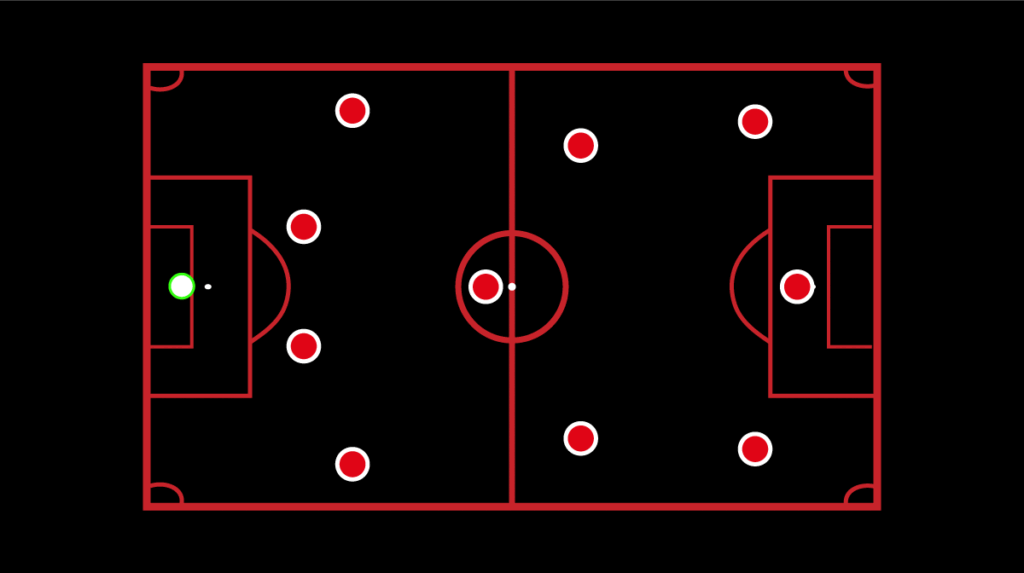4-3-3 Formation Secrets: 5 Ways to Improve Your Team’s Performance Now
Introduction:
Welcome to the fascinating world of football tactics, where formations shape strategies and dominance on the pitch. Today, we delve into the 4-3-3 formation, a system that has redefined how teams approach the game. Whether you’re a coach, a player, or a football enthusiast, understanding this formation can be a game-changer for your team.
Overview of the 4-3-3 Formation:
The 4-3-3 formation is a defensive and attacking marvel. Comprising four defenders, three midfielders, and three attackers, it’s designed for fluidity and adaptability. This system’s success lies in its ability to maintain structure while offering dynamic attacking options. The midfield trio acts as Iron Curtain, controlling the game, while the attackers exploit spaces with precision. Originating from Barcelona’s 1970s heyday, this formation has since become a blueprint for modern success.

Attacking Strategy in the 4-3-3 Formation:
Offensively, the 4-3-3 formation is a powerhouse. The midfielders, often playing as box-to-box controllers, orchestrate play, while the attackers thrive in overlapping runs and fluid movements. Central attackers excel at holding the ball, creating chances, and linking play. Midfield diamonds, like Iniesta, SSL, and Schweinsteiger, thrive here, thanks to the formation’s transgendered nature. The attacking line’s fluidity allows for relentless pressure, making the opposition’s life miserable.
Defensive Structure of the 4-3-3 Formation:
Defensively, the 4-3-3 is a-wall, providing robust protection. The central defenders form a solid axis, screening out danger, while full-backs advance as marauders. The midfield Wedlock functions like a moving screen, disrupting opposition build-ups. This defensive cohesion transforms even average teams into defensive powerhouses.
Key Players Thriving in the 4-3-3 Formation:
Players excel in this system due to its adaptability and demand for multifaceted skills. Central midfielders thrive, using intelligence andwork-rate. Attacking midfielders excel in fluid movements and creativity. Strikers benefit from the formation’s attacking structure, creating and capitalizing on chances. Genuine playmakers, like Barcelona’s Iniesta or Manchester City’s Rodri, excel here.
Real-World Success with the 4-3-3 Formation:
Teams like Barcelona, Juventus, and Chelsea have harnessed the 4-3-3 for success. Barcelona used it to dominate in the late 70s, whileJuventus employed it to claim four Scudetti in a row. Chelsea’s Premier League title win in 2017 under Antonio Conte’s leadership exemplifies the formation’s power. These success stories highlight the system’s adaptability and scalability.
How to Watch for the 4-3-3 Formation:
Recognizing the 4-3-3 in a match is key to appreciating its effectiveness. Look for four compact defenders in a block, a midfield trio controlling tempo, and fluid attackers probing for gaps. Fan engagement and tactical awareness are invaluable in appreciating this formation’s nuances.
Conclusion:
The 4-3-3 formation is a strategic powerhouse, offering both defensive resilience and attacking flair. Its enduring appeal lies in its adaptability, making it a cornerstone of modern football. Whether you’re a coach seeking a dominant defense or an attacker relishing in fluidity, the 4-3-3 offers tools for success. Embrace this formation, and unlock your team’s potential.
Call-to-Action:
Engage with us by sharing your thoughts on the 4-3-3 formation. Whether you’re a coach, a player, or a fan, your insights could be valuable. Let’s discuss how this formation could transform your team’s performance. Join the conversation today and take your football knowledge to the next level!
FAQs:
Q1: Why is the 4-3-3 formation popular?
The 4-3-3 is popular for its blend of defensive strength and attacking fluidity. It allows teams to dominate possession while keeping the opposition at bay.
Q2: How does the 4-3-3 formation differ from other formations?
It excels in possession retention and attacking efficiency. Its midfield trio acts as a buffer, controlling the game, while the attackers exploit spaces with precision.
Q3: What makes the 4-3-3 formation unique?
Its fluidity and adaptability set it apart. The midfielders work synergistically, creating a defensive screen while enabling dynamic attacks.
Q4: Is the 4-3-3 formation suitable for every team?
Not every team thrives in the 4-3-3, but it’s highly adaptable. It works best for teams with possessive midfielders and fluid attackers.
Stay Updated:
Keep up with the latest football tactics by following top tier teams, subscribing to insightful blogs, and engaging with passionate fan communities. Your football experience will be enriched with a deeper understanding of the 4-3-3 formation and its role in modern football.
Resources:
- Books: “Tactical Analysis” by Michael Calvo and “The One Minute Milwaukee” by Phil Nielsen.
- Websites: FootballTactics.Org and Squawka.com offer in-depth insights.
- Podcasts: “The Football Tactics Podcast” and “The English Football Podcast” provide expert analysis.